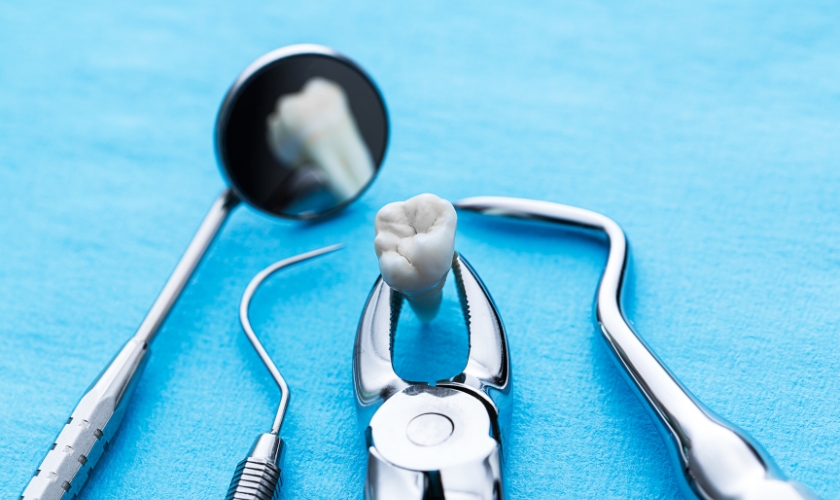
Tooth extractions in Dallas, TX, are common dental procedures that many people undergo at some point in their lives. The level of pain experienced during and after a tooth extraction can vary significantly depending on several factors. Understanding which tooth extractions are the most painful can help patients better prepare mentally and physically for the procedure, reducing anxiety and ensuring a smoother recovery.
Various factors influence the pain associated with tooth extractions, including the type of extraction, the condition of the tooth, and the patient’s pain tolerance. Simple extractions, which involve removing teeth that are visible and easily accessible, generally cause less discomfort. On the other hand, surgical extractions, which may involve removing impacted teeth or teeth that have not fully erupted, tend to be more complex and potentially more painful.
In this blog, we will explore the different types of tooth extractions and discuss which ones are typically considered the most painful. We will also provide insights into pain management strategies and what patients can expect during the recovery process. By understanding these aspects, you can approach your dental procedure with confidence and minimal discomfort. Let’s delve into the specifics of tooth extractions, starting with the various types and what makes them more or less painful.
Types of Tooth Extractions
Understanding the types of tooth extractions is crucial in assessing the potential pain involved. There are two primary types:
Simple Extractions
- Definition: Simple extractions involve removing teeth that are visible and easily accessible in the mouth.
- Procedure: The dentist loosens the tooth with an instrument called an elevator and removes it using forceps.
- Pain Level: Generally causes less discomfort and pain, often managed with local anesthesia.
Surgical Extractions
- Definition: Surgical extractions are more complex and involve removing teeth that are not easily accessible, such as impacted teeth or teeth that have not fully erupted.
- Procedure: This involves making an incision in the gum to access the tooth and may require breaking the tooth into smaller pieces for removal.
- Pain Level: Typically more painful due to the invasive nature of the procedure, requiring more advanced pain management techniques.
Wisdom Tooth Extractions
Wisdom teeth are often extracted due to a lack of space in the mouth, improper eruption, or impaction. This type of extraction can be particularly challenging:
- Complexity: Wisdom teeth are often impacted or partially erupted, making the extraction process more complicated.
- Pain Levels: The pain experienced during wisdom tooth extractions can be significant due to the depth of the tooth and its position in the jawbone.
- Recovery: Patients may experience swelling, bruising, and significant discomfort for several days post-extraction.
Impacted Tooth Extractions
Impacted teeth remain embedded in the gum or bone, often due to a lack of space or improper alignment.
- Definition: An impacted tooth fails to emerge properly from the gums.
- Pain Levels: Extractions of impacted teeth are usually more painful because they require surgical intervention to remove the tooth from its embedded position.
- Post-Extraction Pain Management: Effective pain management techniques include prescribed pain medications and cold compresses to reduce swelling.
Front vs. Back Teeth Extractions
Pain levels can also differ based on whether the extraction involves front or back teeth:
- Front Teeth: Generally easier to extract and cause less pain due to their single root structure.
- Back Teeth: Often more painful due to multiple roots and their position in the mouth, which can make the extraction process more difficult.
Factors Influencing Pain During Extraction
Several factors can affect the level of pain experienced during a tooth extraction:
- Condition of the Tooth: Severely decayed or infected teeth may cause more pain.
- Pain Tolerance: Individual pain thresholds vary.
- Dentist’s Skill: The experience and technique of the dentist can significantly impact the pain experienced during and after the procedure.
Pain Management Strategies
Effective pain management is essential for a comfortable recovery:
- Pre-Extraction Preparations: Discuss pain management options with your dentist in Dallas, TX.
- Pain Relief Options: Local anesthetics, sedatives, and post-operative medications.
- Post-Extraction Care: Follow home care instructions carefully, including using prescribed medications and home remedies like saltwater rinses.
Personal Experiences and Expectations
Individual experiences with tooth extractions can vary widely:
- Variability: Pain levels and recovery times differ from person to person.
- Expectations: Set realistic expectations for the recovery process.
- Communication: Discuss any concerns or anxieties with your Dallas dentist beforehand.
When to Seek Help?
It’s essential to know when to seek additional help post-extraction:
- Signs of Complications: Excessive bleeding, severe pain, or signs of infection.
- Dental Follow-Up: Contact your dentist in Dallas, TX, if any complications arise or if pain persists beyond the expected recovery period.
Understanding which tooth extractions in Dallas, TX, tend to be the most painful and how to manage pain effectively can greatly ease your experience. Always communicate openly with your dental professional about your concerns and follow their recommendations for a smooth recovery. Being informed and prepared will help you navigate the extraction process with confidence and minimal discomfort.



